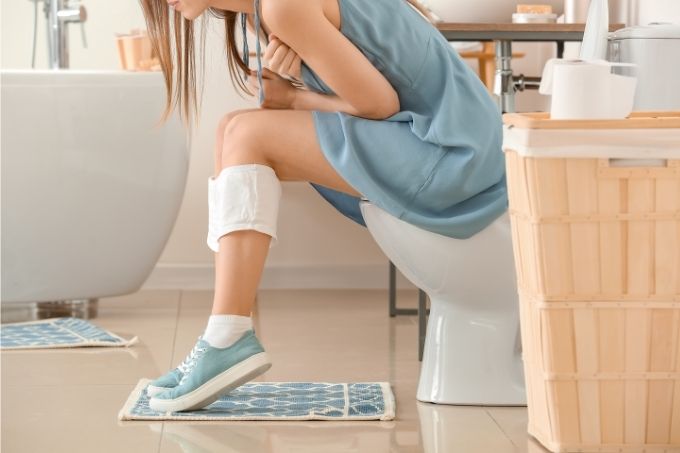
Pregnancy and delivery come with several other different issues as if keeping the baby in your womb for 9 months and delivering it wasn’t already the hardest thing ever. The body goes through many changes during this whole process and it’s not rare to witness some complications and conditions just after the delivery. One of the most common conditions that most women after delivery witness is postpartum hemorrhoids.
What are hemorrhoids?
Hemorrhoids are swollen veins in the rectal area. When these blood vessels become unusually swollen, you will feel a soft mass that may stick out of your anus. Hemorrhoids can range in size from as small as raisin to as large as a grape. They can be merely itchy or downright painful and may even cause rectal bleeding, especially when you have a bowel movement.
Hemorrhoids are common during pregnancy and the postpartum period. In most cases, hemorrhoids that developed during pregnancy will go away on their own soon after you give birth, especially if you are careful to avoid constipation (with some simple measures). But sometimes they persist. About 25 percent of women who develop hemorrhoids after giving birth still have them at six months postpartum. They may shrink, however, and symptoms may come and go.
What causes postpartum hemorrhoids?
Hemorrhoids are common during the third trimester of pregnancy and one month after the delivery. In a study of 280 women who gave birth, 43% had hemorrhoids. Many of these women had related conditions, such as constipation during pregnancy, and pushing for more than 20 minutes during delivery.
Hemorrhoids are caused by the pressure on the veins in your rectum or anus. Veins have valves to help the blood flow towards your heart. But when these valves are weakened because of pressure, blood can pool in the veins. This makes them swell up, similar to the way varicose veins form. Pregnant women have the additional weight of their baby sitting on their abdomen and pelvis. This makes it hard for the blood to return from the pelvis area.
Many pregnant women also have constipation, or fewer than three bowel movements a week. This can be due to:
- Hormonal changes that affect the digestive system
- Diet changes during pregnancy
- Moving less
- Too much iron due to taking iron supplements
- The growing baby presses on the mother’s intestines and affects digestion
Constipation is also common after giving birth. In many women, this could be caused by a combination of changing hormones, pain medication, dehydration, or a fear of pain from their hemorrhoids or episiotomy site (a surgical cut made between the vagina and anus as you give birth). Hemorrhoids can get worse with straining and constipation. If you have hemorrhoids when you are pregnant, you will likely experience worse postpartum hemorrhoids.
Symptoms of postpartum hemorrhoids
Hemorrhoids can be internal, where they form inside the rectum. They can also be external, located around the anal opening. Symptoms of postpartum hemorrhoids include:
- Pain in the anal area
- Itchiness in the anal area
- Bleeding during bowel movements
- Sensitive lumps near the anus.
How to get rid of postpartum hemorrhoids?
Most cases of hemorrhoids resolve on their own, but there are several things you can do to speed healing time and reduce discomfort. Here are a few natural remedies that are safe to use while pregnant and breastfeeding.
- Avoid straining: Straining during a bowel movement puts more pressure on your rectal area. To give yourself time to heal, be mindful not to push, strain, or bear down when sitting on the toilet. Try to let gravity do most of the work.
- Add fiber to your diet: Dietary fiber helps to soften your stool while also giving it more bulk. A high fiber diet can help treat and prevent constipation, which makes hemorrhoids worse. High-fiber foods include fruits, vegetables, and whole grains.
- Drinking plenty of water: Staying hydrated also helps to prevent constipation
- Soak the area: Soothe pain and irritation by soaking the area in warm bathwater for 10 to 15 minutes, two to three times per day. You can use your bathtub or use a sitz bath.
- Keep the area clean: Keeping your anal area clean will help to prevent any additional irritation that might get in the way of the healing process. Rinsing the area with warm water should be enough.
- Use moistened wipes: Moistened wipes are gentler than dry toilet paper. Opt for fragrance-free wipes to avoid any irritation.
- Apply a cold pack: Use a clean ice pack or cold compress to reduce painful swelling. Just make sure to wrap it in a towel or cloth before placing it directly on your skin.
- Don’t sit too long and do exercise.
Topical medications and supplements can also help treat the symptoms of hemorrhoids. If you are pregnant or breastfeeding, talk to your doctor before using any new over-the-counter treatments. These treatments include:
- Stool softeners: Stool softeners help to moisten your stool so it can easily pass through your intestines.
- Fiber supplements: If dietary adjustments aren’t enough, you can consider taking a fiber supplement. These come in a number of forms, including drink mixes. If you are pregnant or breastfeeding, make sure to talk to your doctor first.
- Medicated wipes: medicated wipes, which often contain witch hazel, hydrocortisone, or lidocaine, can help relieve itchiness, pain, and inflammation.
- Hemorrhoids creams and suppositories: Hemorrhoid creams and suppositories help reduce inflammation and pain both internally and externally.